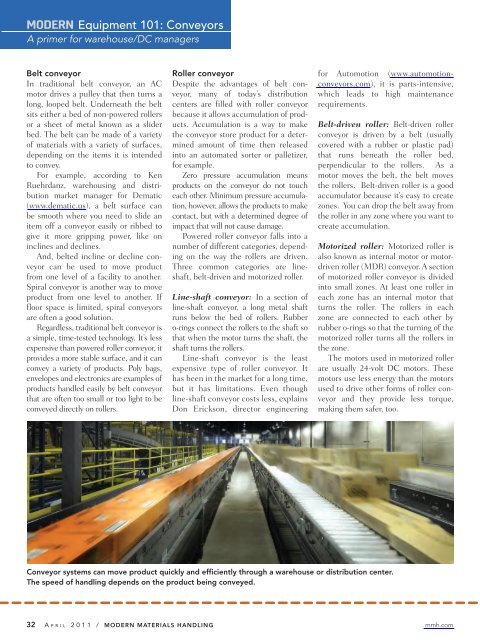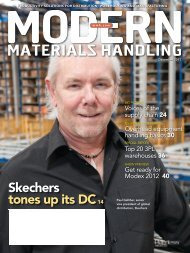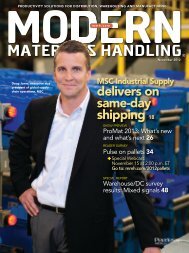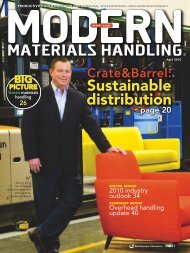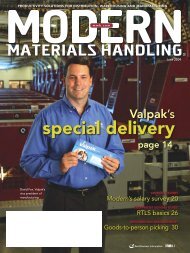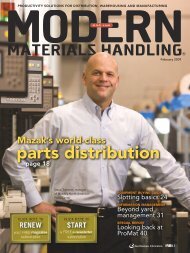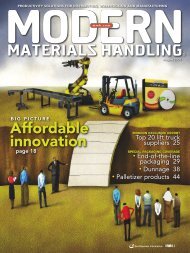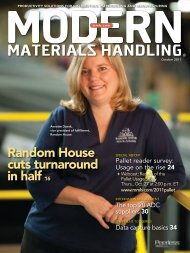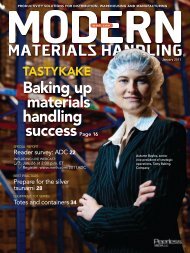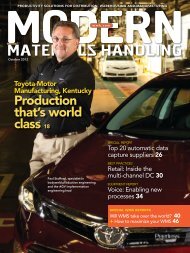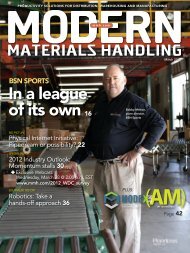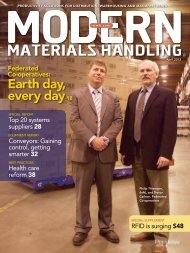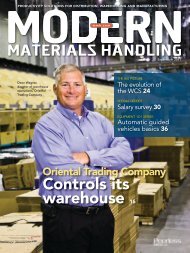Modern Materials Handling - April 2011
Modern Materials Handling - April 2011
Modern Materials Handling - April 2011
You also want an ePaper? Increase the reach of your titles
YUMPU automatically turns print PDFs into web optimized ePapers that Google loves.
modern Equipment 101: ConveyorsA primer for warehouse/DC managersBelt conveyorIn traditional belt conveyor, an ACmotor drives a pulley that then turns along, looped belt. Underneath the beltsits either a bed of non-powered rollersor a sheet of metal known as a sliderbed. The belt can be made of a varietyof materials with a variety of surfaces,depending on the items it is intendedto convey.For example, according to KenRuehrdanz, warehousing and distributionmarket manager for Dematic(www.dematic.us), a belt surface canbe smooth where you need to slide anitem off a conveyor easily or ribbed togive it more gripping power, like oninclines and declines.And, belted incline or decline conveyorcan be used to move productfrom one level of a facility to another.Spiral conveyor is another way to moveproduct from one level to another. Iffloor space is limited, spiral conveyorsare often a good solution.Regardless, traditional belt conveyor isa simple, time-tested technology. It’s lessexpensive than powered roller conveyor, itprovides a more stable surface, and it canconvey a variety of products. Poly bags,envelopes and electronics are examples ofproducts handled easily by belt conveyorthat are often too small or too light to beconveyed directly on rollers.Roller conveyorDespite the advantages of belt conveyor,many of today’s distributioncenters are filled with roller conveyorbecause it allows accumulation of products.Accumulation is a way to makethe conveyor store product for a determinedamount of time then releasedinto an automated sorter or palletizer,for example.Zero pressure accumulation meansproducts on the conveyor do not toucheach other. Minimum pressure accumulation,however, allows the products to makecontact, but with a determined degree ofimpact that will not cause damage.Powered roller conveyor falls into anumber of different categories, dependingon the way the rollers are driven.Three common categories are lineshaft,belt-driven and motorized roller.Line-shaft conveyor: In a section ofline-shaft conveyor, a long metal shaftruns below the bed of rollers. Rubbero-rings connect the rollers to the shaft sothat when the motor turns the shaft, theshaft turns the rollers.Line-shaft conveyor is the leastexpensive type of roller conveyor. Ithas been in the market for a long time,but it has limitations. Even thoughline-shaft conveyor costs less, explainsDon Erickson, director engineeringfor Automotion (www.automotionconveyors.com),it is parts-intensive,which leads to high maintenancerequirements.Belt-driven roller: Belt-driven rollerconveyor is driven by a belt (usuallycovered with a rubber or plastic pad)that runs beneath the roller bed,perpendicular to the rollers. As amotor moves the belt, the belt movesthe rollers. Belt-driven roller is a goodaccumulator because it’s easy to createzones. You can drop the belt away fromthe roller in any zone where you want tocreate accumulation.Motorized roller: Motorized roller isalso known as internal motor or motordrivenroller (MDR) conveyor. A sectionof motorized roller conveyor is dividedinto small zones. At least one roller ineach zone has an internal motor thatturns the roller. The rollers in eachzone are connected to each other byrubber o-rings so that the turning of themotorized roller turns all the rollers inthe zone.The motors used in motorized rollerare usually 24-volt DC motors. Thesemotors use less energy than the motorsused to drive other forms of roller conveyorand they provide less torque,making them safer, too.Conveyor systems can move product quickly and efficiently through a warehouse or distribution center.The speed of handling depends on the product being conveyed.32 A p r i l 2 0 1 1 / <strong>Modern</strong> <strong>Materials</strong> <strong>Handling</strong> mmh.com


